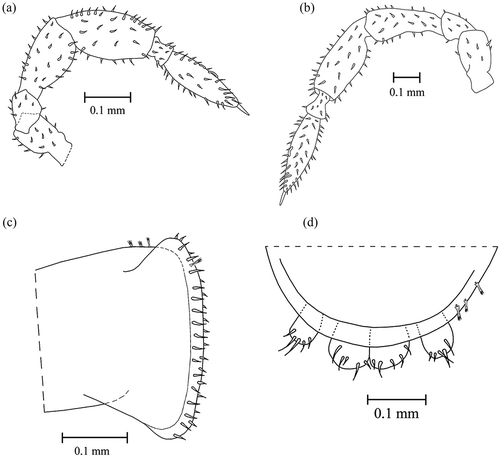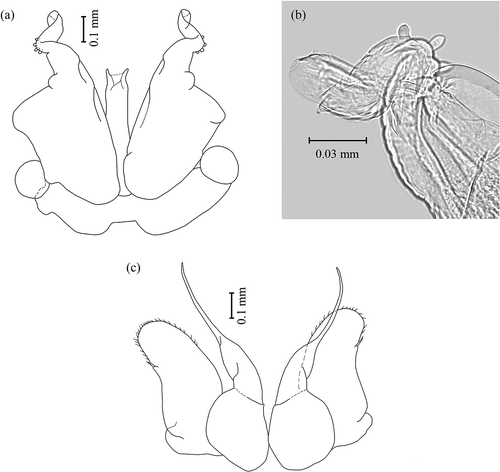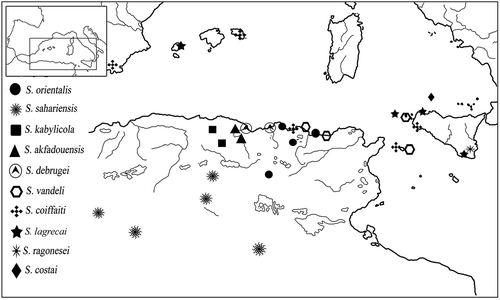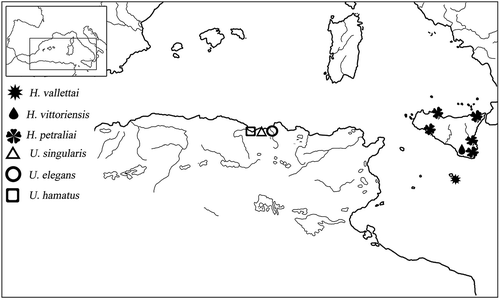Abstract
On the basis of the study of a rich collection of Spelaeoniscidae from Sicily, the surrounding islands, the Maltese Archipelago and North Africa, collected during several faunistic expeditions, two new genera, Uncuniscus and Hybleoniscus, and four new species, Spelaeoniscus akfadouensis, Uncuniscus singularis, Uncuniscus elegans and Hybleoniscus vittoriensis, are described. The genus Spelaeoniscus Racovitza, 1907 is redefined and revised, and all species of the genus are briefly described and illustrated. Moreover, hypotheses on the differentiation process of the above genera and species are proposed based on their geographic distribution.
http://zoobank.org/urn:lsid:zoobank.org:pub:9DF065E3-B8E7-488E-85F2-7E267BDC87AD
Introduction
The study of a rich collection of terrestrial isopods of the family Spelaeoniscidae, from Sicily, the surrounding islands, the Maltese Archipelago and North Africa, collected during several faunistic expeditions, showed a marked uniformity in these isopods in relation to their general morphology (a)–(c)). Thus, at first examination, all these species could easily be attributed to the genus Spelaeoniscus Racovitza, Citation1907. As occurs in other Oniscidea families, the absence of males makes the specific identification of these animals difficult. However, the careful examination of male secondary sexual characters showed that a marked differentiation of these structures counteracts the abovementioned morphological uniformity; the high level of differentiation of male secondary sexual characters suggests the existence of three groups of species that are so distinctly separated, as below illustrated, as to be considered to belong to three different genera, two of which are erected here as new genera.
Figure 1. (a) Spelaeoniscus akfadouensis sp. nov., lateral view of whole animal; (b) Uncuniscus gen. nov. hamatus (Caruso & Lombardo) comb. nov. lateral view of whole animal; (c) Hybleoniscus gen. nov. vittoriensis sp. nov., lateral view of whole animal; (d) Spelaeoniscus akfadouensis sp. nov., cephalon in frontal view.
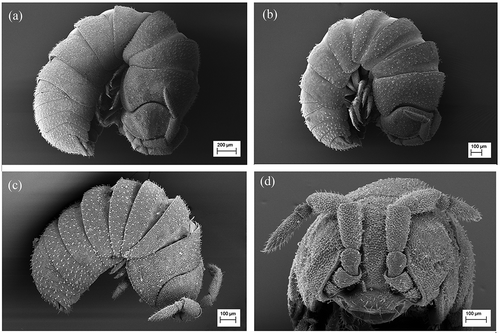
The discovery of some Sicilian populations in the valley of Acate (RG), recognised as new species and similar to two species previously described, Spelaeoniscus vallettai Caruso, Citation1975 and Spelaeoniscus petraliai Caruso & Lombardo, 1977, has led us to establish the new genus Hybleoniscus to host all the three species. Caruso and Lombardo (Citation1977a) described S. petraliai from Sicily (Italy). The authors mentioned that this species, together with S. valletai (from Malta island) greatly differs from its congeners.
Later, Caruso and Lombardo (Citation1978) described Spelaeoniscus hamatus from Algeria. The authors observed that this species was very distinct from its congeners based on the presence of a median ventral hook directed frontwards in the base of the telson, and pleopods 5 elongated and folded forwards, forming a groove which the hook fits into (). The discovery of two further new species with the structures described above lead us to erect the new genus Uncuniscus. The three species are easily distinguishable from each other by the morphology of the male pleopods, as we explain below.
Figure 2. Uncuniscus gen. nov. hamatus (Caruso & Lombardo) comb. nov. (a) Pleon, ventral view; the pleopods have been removed; the arrow indicates the hook; (b) hind portion of body, ventral view; (1) hook; (2) exopodites of the fifth pair of pleopods (from Caruso & Lombardo Citation1978; permission to publish granted by Caruso and Lombardo).

For these reasons, we consider it useful to proceed with a review of all known species of Spelaeoniscus.
For each known species, we provide a brief diagnosis and some useful figures for its identification. The new genera and the new species are described and drawn in detail.
Materials and methods
The specimens were kept in 75% ethanol. Identification was based on morphological characters. The new taxa are illustrated with figures prepared with the aid of a camera lucida mounted on a Leitz Wetzlar optical microscope from slide-mounted samples. The photographs were taken using a Leica EC3 camera mounted on a Leica DME optical microscope. Some photographs were taken using a scanning electron microscope (SEM). The place names of collection from North African sites were recorded using a Michelin Road Map 172 (Algeria and Tunisia), 8th edition, 1978. The type specimens are preserved at the Museo di Zoologia, Dipartimento di Scienze Biologiche, Geologiche e Ambientali, Sezione di Biologia Animale “Marcello La Greca”, University of Catania. The diagnoses of the already described species of Spelaeoniscus are inferred from the original descriptions.
Abbreviations used are as follows: TP, Trapani Province; SR, Siracusa Province; AG, Agrigento Province; ME, Messina Province; PA, Palermo Province; RG, Ragusa Province; MZ-DBA, “Museo di Zoologia, Sezione di Biologia Animale ‘Marcello La Greca’ del Dipartimento di Scienze Biologiche, Geologiche ed Ambientali”, University of Catania.
Systematics account
Family SPELAEONISCIDAE Vandel, Citation1948
Genus Spelaeoniscus Racovitza, Citation1907
Type species: Spelaeoniscus debrugei Racovitza, Citation1907
Revised diagnosis
Small animals, maximum body length: 6 mm. Animals able to roll up into a ball. Antennulae with two segments. Exoantennal conglobation (a) and (d)). Cephalon with slightly marked antennal furrows not reaching its posterior margin. Antennae extended during conglobation. Presence of posterolateral schisma on epimera of first pereionite (). Male pleopod 1 endopods positioned on single plane; endopods’ apical portion remarkably different in the various species.
Figure 3. Spelaeoniscus debrugei Racovitza, Citation1907. (a) Adult male during the rolling-up process; (b) cephalon in frontal view (redrawn from Racovitza Citation1908).
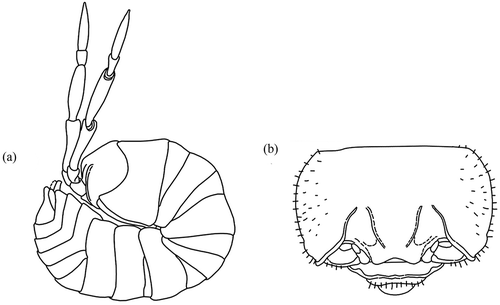
Remarks
The genus Spelaeoniscus was established by Racovitza (Citation1907) when he described S. debrugei from two North African caves. The genus was considered by the author to be troglobiotic. The genus includes 11 species and only one of them, Spelaeoniscus ragonesei Caruso & Lombardo, 1977, comes from a Sicilian cave and appears to be a troglobiotic species (Caruso & Lombardo Citation1977b). The 10 species listed below are all distinguishable by the morphology of the apices of the male pleopod 1 endopods, as hereinafter briefly described and illustrated.
Spelaeoniscus differs from Triceratosphoera Caruso & Lombardo, Citation1978 in the number of antennuale articles, the rolling-up mechanism and the extension of antennal furrows; from Albertosphoera Caruso & Lombardo, Citation1983 in the rolling-up mechanism and the extension of antennal furrows; from Desertosphoera Vandel, Citation1948 in the extension of antennal furrows; from Barbarosphoera Vandel, Citation1948 in the rolling-up mechanism; from Maghreboniscus Vandel, Citation1959 in the rolling-up mechanism and the extension of antennal furrows; from Atlantoniscus Vandel, Citation1959 in the rolling-up mechanism and the extension of antennal furrows; from Uncuniscus gen. nov. in lacking the hook-like process at telson base in males; from Hybleoniscus gen. nov. in the shape of the male pleopod 1 endopods.
The differences among all the genera of the family Spelaeoniscidae are reported in detail in .
Table I. Differences among the genera of the family Spelaeoniscidae.
Spelaeoniscus debrugei Racovitza, Citation1907
( and a))
Figure 4. (a) Spelaeoniscus debrugei Racovitza, Citation1907. Apex of the first male pleopod endopodite (redrawn from Racovitza Citation1908); (b) Spelaeoniscus sahariensis Paulian De Felice, Citation1942. First male pleopod (redrawn from Vandel Citation1959); (c) Spelaeoniscus orientalis Vandel, Citation1959. Apex of the first male pleopod endopodite (redrawn from Vandel Citation1959); (d) Spelaeoniscus kabylicola Vandel, Citation1948. First male pleopods (redrawn from Vandel Citation1948); (e) Spelaeoniscus coiffaiti Vandel, Citation1961. First male pleopod (redrawn from Montesanto et al. Citation2011).
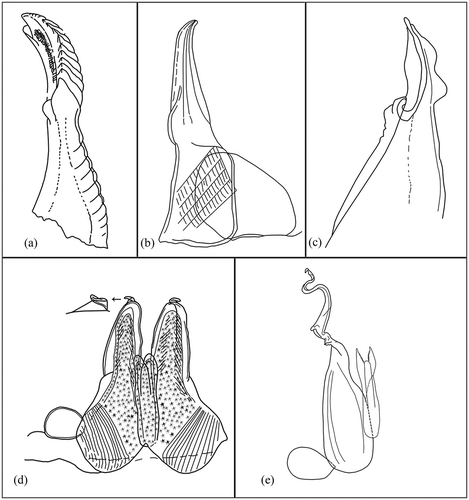
Spelaeoniscus debrugei Racovitza, Citation1907: 69, figs 1–3; 1908: 399, pl. 22, figs 308–322, pl. 23, figs 323–336; Vandel, Citation1948: 403; 1955: 77; 1959: 131; Schmölzer, Citation1965: 288; Caruso, Citation1982: 611; Schmalfuss, Citation2003: 239.
Previous records
ALGERIA: Bejaïa, Constantine Province, Pic des Singes, inside a cave, 5 October 1906, three males and two juveniles; Tababort, Constantine Province, Cave de la Madeleine, 11 October 1906, one male (Racovitza, Citation1908).
Diagnosis
Maximum body length: 4 mm. Colour and eyes absent. Male pleopod 1 exopods small and ovoid; endopods with irregular triangles spoon-like on apical part and striate on outer margin (a)) (Racovitza Citation1908).
Distribution
Algeria.
Spelaeoniscus sahariensis Paulian De Felice, Citation1942
(b))
Spelaeoniscus sahariensis Paulian De Felice, Citation1942: 403, figs 1–7; Vandel, Citation1948: 403; 1959: 129, figs 8 and 9; Schmölzer, Citation1965: 287, figs 1129–1130; Schmalfuss, Citation2003: 240.
Previous records
ALGERIA: 30 km south of Ghardaia on the road to El Golea, in the Algerian Sahara, May 1942, one female (Paulian De Felice, Citation1942); Bou Saada, west of Biskra, in the oases, 17 April 1951, one male, one female and one juvenile (P. Remy leg.); Ouargla, between Touggourt and El Golea, in the Algerian Sahara, in the oases, 12 April 1951, one juvenile; Aïn Sefra, on the road between Oran and Figuig, in the Algerian Sahara; in the oases and on the shores of a wadi, 27 September 1950, three specimens (P. Remy leg.).
MOROCCO: Figuig, in the oases, 23–25 September 1950, 20 adult specimens and numerous juveniles (P. Remy leg.).
Diagnosis
Diameter of rolled-up specimens: 1.75 mm. Colour yellowish-white. Eyes generally absent but if present consisting of four well-pigmented ommatidia. Male pleopod 1 exopods rectangular with rounded angles; endopod with apical portion slightly bent outwards (b)) (Vandel Citation1959).
Distribution
Algeria and Morocco.
Spelaeoniscus orientalis Vandel, Citation1959
((c))
Spelaeoniscus orientalis Vandel, Citation1959: 132, fig. 10; Schmölzer, Citation1965: 288, fig. 1131; Schmalfuss, Citation2003: 239.
Previous records
ALGERIA: Hippone, in the proximity of Bone, 1 September 1946, three specimens; Philippeville, 13 October 1946, one specimen; Saint Charles, south of Philippeville, in orange groves, 40 m above sea level (asl), 12 October 1946, one male; Batna, 30 September 1946, one male (P. Remy leg.).
Diagnosis
Diameter of rolled-up specimens: 1.75 mm. Specimens without pigment and eyes. Male pleopod 1 exopods ovoid and narrower on outer sides; endopods tapering and ending with tip clearly separate from the rest of the article () (Vandel Citation1959).
Distribution
Algeria.
Spelaeoniscus kabylicola Vandel, Citation1948
((d))
Spelaeoniscus kabylicola Vandel, Citation1948: 17, figs 12–19; Citation1955: 352, fig. 9; 1959: 133; Schmölzer, Citation1965: 287, figs 1125–1126; Schmalfuss, Citation2003: 239.
Previous records
ALGERIA: Fort-National, Aïn Tilioua, on a mountain in Kabylia, 900 m asl, 5 October 1946, one male and two females; Michelet, Tizi n’Djemaa, on a mountain in Kabylia, 1200 m asl, 7 September 1946, one female (P. Remy leg.).
Diagnosis
Maximum body length: 5 mm. Colour absent. Eyes reduced or absent. Male pleopod 1 exopods small and ovoid; endopods stout with apex directed outwards ((d)) (Vandel Citation1948).
Distribution
Algeria.
Spelaeoniscus coiffaiti Vandel, Citation1961
(e))
Spelaeoniscus coiffaiti Vandel, Citation1961: 252, figs 1 and 2; Schmölzer, Citation1965: 287, figs 1127–1128; Garcia & Cruz, Citation1996: 83; Schmalfuss, Citation2003: 239; Garcia, Citation2006: 307, fig. 1; Montesanto et al., Citation2011: 1926, figs 1 and 2.
Previous records
MINORCA: San Luis: station Radio, 27 December 1958, one female; San Cristobal: route de Mercadal, 29 December 1958, two females; Mahon: route de Villa Carlos, 29 December 1958, two males; Mahon: San Antonio, 30 December 1958, two males; Mahon: route de Fornells, 30 December 1958, one male and two females (Coiffait leg.).
SPAGNA: Murcia: La Alqueria, Jumilla, in the soil of olive groves, 30 November 2003, two males and one female (Lencina leg.).
Material examined
SICILY: Trapani (TP), 1 km from Mazara del Vallo, on the road to Torretta Granitola, 37°37ʹ37ʹ’ N, 12°36ʹ58ʹ’ E (WGS84), 2 November 1997, eight males and 45 females (Caruso leg.) (MZ-DBA).
PANTELLERIA: Bagno Asciutto, autumn 2002, 10 males and six females (Massa leg.) (MZ-DBA); Tikiriki, autumn 2002, 14 males and six females (Massa leg.) (MZ-DBA).
ALGERIA: Beach of Seraidi, 19 October 1989, one male (Caruso leg.) (MZ-DBA).
Diagnosis
Maximum body length: 2 mm. Colour yellowish with small traces of pigment on cephalon. Eyes usually absent, but if present exhibit small traces of pigment. Male pleopod 1 exopods egg-shaped and small; endopods long, with long and twisted tip (e)) (Montesanto et al. Citation2011).
Distribution
Western Mediterranean.
Spelaeoniscus lagrecai Caruso, Citation1973
(a))
Figure 5. (a) Spelaeoniscus lagrecai Caruso, Citation1973, exopodites and endopodites of the first male pleopods (from Caruso Citation1973); (b) Spelaeoniscus costai Caruso & Lombardo, Citation1976, exopodites and endopodites of the first male pleopods (from Caruso & Lombardo Citation1976); (c) Spelaeoniscus vandeli Caruso, Citation1976, exopodites and endopodites of the first male pleopods (from Caruso Citation1976); (d) Spelaeoniscus ragonesei Caruso & Lombardo, 1977, exopodite and endopodite of the first male pleopods (from Caruso & Lombardo Citation1977b; permission to publish granted by Caruso and Lombardo).
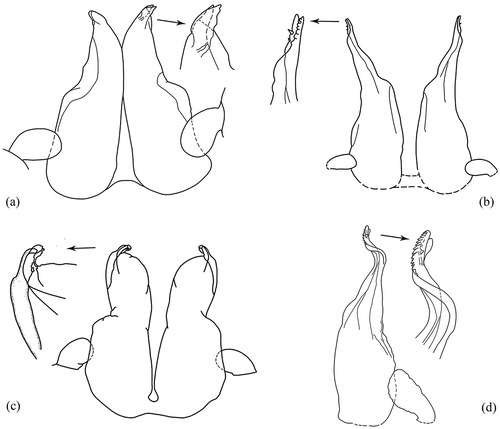
Spelaeoniscus lagrecai Caruso, Citation1973: 73, figs 5–16; Caruso et al., Citation1987: 106; Schmalfuss, Citation2003:239.
Previous records
Type material re-examined
MARETTIMO: Towards Punta Troia, 23 February 1972, eight males (Caruso and Costa leg.), type material (MZ-DBA); 17 April 1991, one female (MZ-DBA); all specimens were found under a piece of wood; Case Romane, 12 April 1979, three females (MZ-DBA); below Case Romane, 18 April 1991, 12 females (MZ-DBA) (Caruso leg.).
Additional material examined
SICILY: Scopello (TP)-RNO dello Zingaro, 26 November 1992, five males and 11 females (MZ-DBA); Donnafugata (RG)-Torrente Petraro, 14 February 1987, nine males and 14 females (MZ-DBA); 8 April 1990, six males and 25 females (MZ-DBA) (Caruso leg.).
IBIZA: Can Costa, 7 April 1970, one male (MZ-DBA).
Diagnosis
Maximum body length: 1.5 mm, diameter of 0.9 mm when rolled up. Colour absent, cephalon with small traces of pigments near eyes. Eyes consisting of one large and dark ommatidium. Male pleopod 1 exopods very small and ovoid; endopods considerably stout and apical portion with double tip (a)) (Caruso Citation1973).
Distribution
Sicilia, Marettimo and Ibiza.
Spelaeoniscus costai Caruso & Lombardo, Citation1976
(b))
Spelaeoniscus costai Caruso & Lombardo, Citation1976: 225, figs 2–11; Caruso et al., Citation1987: 106; Schmalfuss, Citation2003: 239.
Previous records
Type material re-examined
USTICA: Capo Falconiera, 3 March 1974, three males, type material (MZ-DBA); 17 April 1976, 10 males and five females (MZ-DBA); 15 March 1986, 10 females (MZ-DBA) (Caruso leg.).
Diagnosis
Maximum body length: females 1.7 mm, males 1.2 mm. Colour absent. Male pleopod 1 with small exopods, endopod thin and elongated with apical portion consisting of two small setae on outer margin, median portion with 5–7 small teeth () (Caruso & Lombardo Citation1976).
Distribution
Ustica.
Spelaeoniscus vandeli Caruso, Citation1976
((c))
Spelaeoniscus vandeli Caruso, Citation1976: 109, figs 2–11; Caruso et al., Citation1987: 106; Caruso & Lombardo, Citation1995: 102; Schmalfuss, Citation2003: 240.
Previous records
Type material re-examined
PANTELLERIA: Punta Limarsi, 10 March 1974, 13 males and 26 females, type material (MZ-DBA); Punta Tracina, 10 March 1974, 37 males and 57 females (MZ-DBA); Faro Spadillo, 11 March 1974, four males and 24 females (MZ-DBA); Lago, 12 March 1974, two males and 81 females (MZ-DBA); 13 March 1974, four females (MZ-DBA); Contrada Serraglio, spring 2002, two males and two females (MZ-DBA), Tikiriki, spring 2002, three males and 10 females (MZ-DBA) (Caruso leg.).
Additional material examined
FAVIGNANA: 24 May 1991, two females and 27 juveniles (MZ-DBA) (Caruso leg.).
ALGERIA: Beach of Seraidi, 19 October 1989, seven males and 18 females (MZ-DBA); coastal dunes of El Kala, 18 October 1989, three males and eight females (MZ-DBA) (Caruso leg.).
Diagnosis
Maximum body length: females 3.4 mm, males 2 mm. Animals pale with traces of pigment on cephalon, epimera of pereion and pleon, and anterior and posterior margins of pereionites. Eyes rarely absent, consisting of single large and dark ommatidium. Male pleopod 1 exopods small endopod stout with narrow apical portion bent inwards; apex consisting of two laminar processes welded together at base ((c)) (Caruso Citation1976).
Distribution
Algeria, Pantelleria and Favignana.
Spelaeoniscus ragonesei Caruso & Lombardo, 1977
((d) and )
Figure 6. Spelaeoniscus ragonesei Caruso & Lombardo, 1977. Scale-spines of pereion (2200×) (from Caruso & Lombardo Citation1977b; permission to publish granted by Caruso and Lombardo).
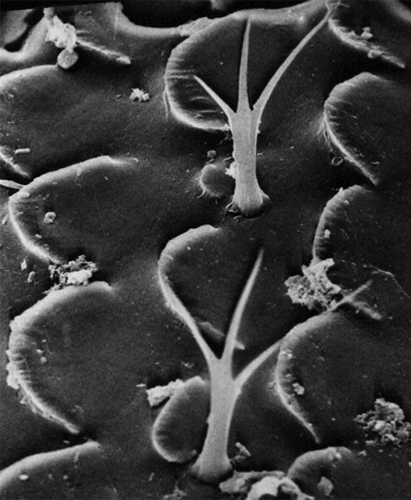
Spelaeoniscus ragonesei Caruso & Lombardo, Citation1977b: 99, figs 1–17; Caruso, Citation1982: 605; Caruso et al., Citation1987: 106; Schmalfuss, Citation2003: 239.
Previous records
Type material re-examined
SICILY: Cave Monsignor Guastella, Vallone Piraro-Noto (SR), 13 October 1977, five males and 17 females (Caruso & Lombardo leg.), type material (MZ-DBA).
Diagnosis
Maximum body length: females 3 mm, males 2.3 mm; maximum diameter 2.3 mm and 1.1 mm when rolled up, respectively. Colour and eyes absent. Scale-setae exclusive to this species ().
Male pleopod 1 exopods small and ovoid with sinuous margins; endopods S-shaped, apical portion twisted and bearing serrate inner margin ((d)) (Caruso & Lombardo Citation1977b).
Distribution
Sicilia.
Remarks
It is likely a troglobitic species.
Spelaeoniscus akfadouensis sp. nov.
(a) and (d), , , , )
Figure 7. Spelaeoniscus akfadouensis sp. nov. holotype and paratype. (a) Antenna of the male; (b) antenna of the female; (c) epimeron of the first pereionite in ventral view; (d) telson and uropods in frontal view.
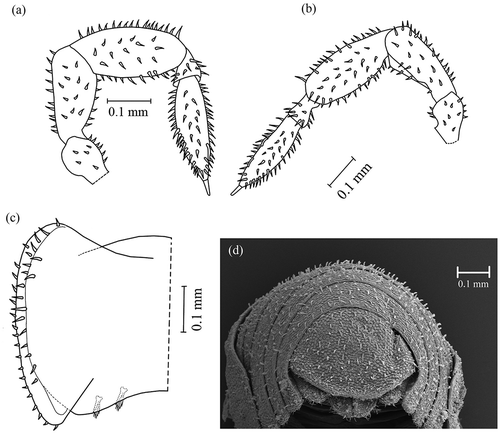
Figure 8. Spelaeoniscus akfadouensis sp. nov. Male. Holotype. (a) Exopodites and endopodites of the first pair of pleopods; (b) detail of the apex of the first pleopod endopodite; the arrow indicates the apical opening; (c) exopodites and endopodites of the second pair of pleopods; (d) exopodites of the third pair of pleopods; (e) exopodite of the fourth pair of pleopods; (f) exopodite of the fifth pair of pleopods.

Figure 9. Spelaeoniscus akfadouensis sp. nov. (a) Lateral view; (b) dorsal view of pereion; (c) dorsal view of pleon; (d) cephalon and antennae in frontal view. Specimens of the typical series.
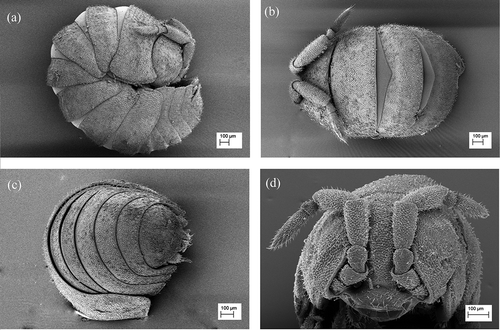
Figure 10. Spelaeoniscus akfadouensis sp. nov. (a) Ventral view of pleon; (b) Antennal apex. Male of the typical series.

Figure 11. Uncuniscus gen. nov. hamatus (Caruso & Lombardo Citation1978). Posterolateral schisma on the epimeron of the first pereionite.
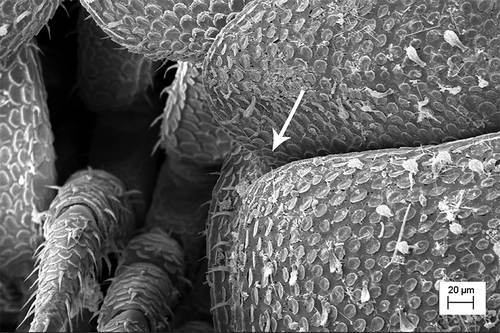
Figure 12. Uncuniscus gen. nov. hamatus (Caruso & Lombardo Citation1978) comb. nov. Male. (a) Exopodite and endopodites of the first pair of pleopods; (b) exopodite of the fifth pair of pleopods (from Caruso & Lombardo Citation1978; permission to publish granted by Caruso and Lombardo).
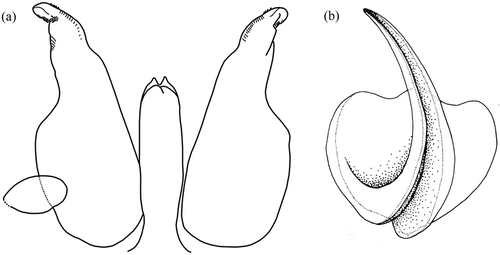
Figure 13. Uncuniscus singularis gen. nov., sp. nov. (a) Antenna of the male; (b) antenna of the female; (c) epimeron of the first pereionite in ventral view; (d) telson and uropods in dorsal view. Specimens of the typical series.
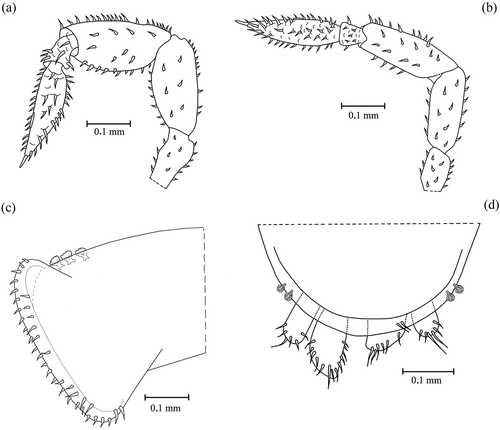
Figure 14. Uncuniscus singularis gen. nov., sp. nov. Male. Holotype. (a,c) Exopodites and endopodites of the first pair of pleopods; (b,d) detail of the apex of the first pleopod endopodite; (e) endopodite of the first pair of pleopods with internal structure everted; (f) exopodite and endopodite of the second pair of pleopods.
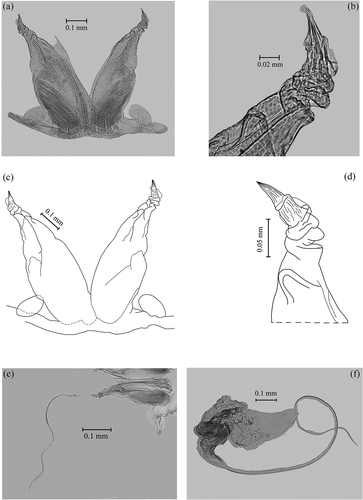
Figure 15. Uncuniscus singularis gen. nov., sp. nov. Male. Holotype. (a) Exopodite and endopodite of the second pair of pleopods; (b) exopodite of the fifth pair of pleopods.
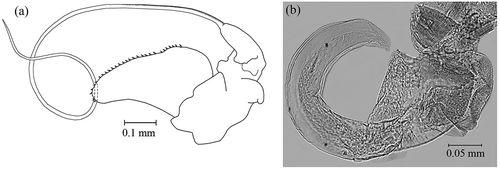
Figure 16. Uncuniscus elegans gen. nov., sp. nov. Male. Holotype. (a) Antenna; (b) epimeron of the first pereionite in ventral view; (c) telson and uropods in dorsal view.

Figure 17. Uncuniscus elegans gen. nov., sp. nov. Male. Holotype. (a) Exopodites and endopodites of the first pair of pleopods; (b) detail of the apex of the first pleopod endopodite; (c) exopodites and endopodites of the second pair of pleopods; (d) exopodite of the fifth pair of pleopods.
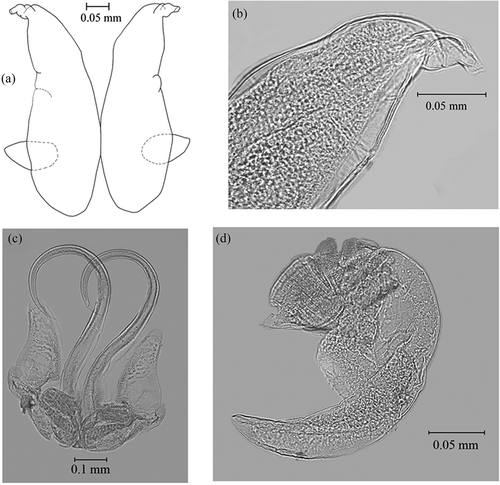
Figure 18. (a) Apex of the male first pleopod endopodite of Hybleoniscus gen. nov. vallettai (Caruso, Citation1975) comb. nov.(1800 x); (b) apex of the first male pleopod endopodite of Hybleoniscus gen. nov. petraliai (Caruso & Lombardo, Citation1977a) comb. nov. (1600×) (from Caruso & Lombardo Citation1977a; permission to publish granted by Caruso and Lombardo).
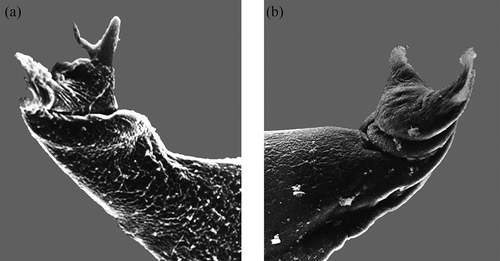
Figure 19. Hybleoniscus gen. nov. vallettai (Caruso, Citation1975) comb. nov. Male. (a) Exopodite and endopodites of the first pair of pleopods; (b) detail of the apex of the first pleopod endopodite (from Caruso Citation1975; permission to publish granted by Caruso).
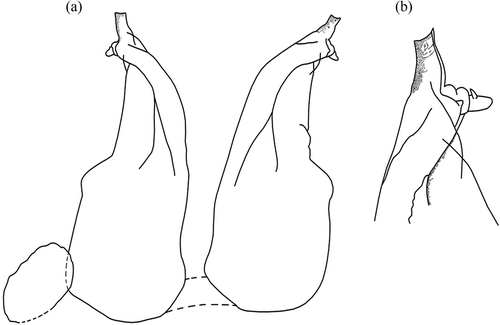
Material examined
ALGERIA: One male holotype, 7 km from Adekar Kebouche, 26 October 1984 (MZ-DBA); 26 male and 42 female paratypes, same data (MZ-DBA); 21 October 1984, seven males (MZ-DBA); Foret de Akfadou, Fontaine des Ifs, 27 October 1984, five males and 12 females (MZ-DBA) (Caruso leg.). All specimens were collected in a grazing land with Asphodelus.
Description
Maximum body length: females 2.5 mm, males 2 mm; maximum diameter 1.5 mm when rolled up ( and a)). Eyes are usually absent but, if present, consisting of single and lightly pigmented ommatidium. Body covered with imbricated scales, with scale-setae between them, arranged in 4–5 rows; scale-setae, when observed with a stereoscopic microscope, appear bent backwards. Cephalon with two short antennal furrows, extending about 1/3 of length, into which antennae fit perfectly during rolling-up process ((d)). Antennal furrows not very deep, delimited by a not well marked sub-triangular scutellum. Antennae short, not surpassing posterior margin of pereionite 1 when extended backwards (); flagellum of two segments, first shorter than second (a) and (b)), provided with aesthetascs (b)). Moderate sexual dimorphism visible on last article of antennae (a) and (b)). Antennules consisting of two segments, second bearing five aesthetascs. Epimera of pereionite 1 with an evident posterolateral schisma, inner lobe longer and larger than outer lobe ((c)).
Telson semi-circular and uropod endopod longer than exopod ((d)).
Male
genital papilla bifurcates apically, S-shaped and ending with two thin tips that probably fit into endopods 1 (a)). Pleopod 1 very strong with small sub-elliptical exopod; endopods with apical portion bearing complex and specialised structures (a)) with two tips: apical tip with opening (a) and (b)); sub-apical tip without opening. Endopods with sub-apical portion surrounded by thin transparent membrane. Pleopod 2 with sub-triangular exopod; inner margins with short spines and setae; apices with laminar lobe; endopods with stout base extended in laminar structure thickened on its inner margin ((c)). Pleopods 3 and 4 exopods ((d)) also modified: the upper margin provided with large laminar lobe bearing one strong spine; pleopod 4 exopod (e)) sub-rectangular with distal large laminar lobe bearing one strong spine. Pleopod 5 without any peculiar shape, with triangular apical portion and distal margin slightly concave bearing some spines (f)).
Etymology
The denomination originates from the name of the forest where we found numerous specimens.
Distribution
Algeria.
Remarks
Spelaeoniscus akfadouensis is the only species with all five male pleopods modified; for this reason this species is immediately distinguishable from the other species of the genus.
Genus Uncuniscus gen. nov.
Type-species: Spelaeoniscus hamatus Caruso & Lombardo, Citation1978
Diagnosis
Small animals, maximum body length 4 mm. Animals able to roll up into a ball. Cephalon with slightly marked antennal furrows not reaching its posterior margin. Antennae remain extended during conglobation. Presence of posterolateral schisma on pereionite 1 epimera into which anterior edges of pereionite 2 epimera fit during rolling up (b) and ). Telson with median ventral hook directed frontwards and pleopod 5 exopods elongated and folded forwards, forming inner groove which the hook fits into (a) and (b)).
Etymology
From the Latin uncus = hook. The denomination refers to the particular structure that is exclusive to this genus.
Remarks
The general morphology of Uncuniscus is similar to that of the genus Spelaeoniscus ().
The different species, Uncuniscus hamatus (Caruso & Lombardo, Citation1978) comb. nov., Uncuniscus singularis sp. nov. and Uncuniscus elegans sp. nov., are easily recognisable by the morphology of the male pleopod tips. This genus differs from Spelaeoniscus in the following male secondary sexual characters: the presence of a single median structure, a hook-like process, more or less developed, that originates at the telson base (a) and (b)); the differences from all the other genera are shown in .
Uncuniscus hamatus (Caruso & Lombardo, Citation1978) comb. nov.
( and )
Spelaeoniscus hamatus Caruso & Lombardo, Citation1978: 209, figs 1–17; Schmalfuss, Citation2003: 239.
Previous records
Type material re-examined
ALGERIA: Tichi Bejaia, 9 April 1977, eight males and 59 females, type material. All specimens were collected near the sea (200–300 m) (MZ-DBA); 5 km east from Tichy Bejaia, 21 April 1982, 27 males and 276 females (MZ-DBA); Tichy Bejaia, 26 October 1984, three males and six females (MZ-DBA); 8 km east from Tichy Bejaia, 21 May 1983, four males and 80 females (MZ-DBA); Aokas, 21 October 1989, two males and one female (MZ-DBA) (Caruso leg.).
Diagnosis
Maximum body length: females 3.5 mm, males 2 mm. Colour light brown; edge eyes darker; males darker than females. Male pleopod 1 exopods small and ovoid; endopods stout and apical portion rounded, bent outwards and with inner margins streaked and provided with short setae (a)). Pleopods 5 as in b). Telson as in a) and (b) (Caruso & Lombardo Citation1978).
Distribution
Algeria.
Uncuniscus singularis sp. nov.
(–)
Material examined
ALGERIA: One male holotype, 5 km east from Tichy Bejaia, 2 March 1981 (Caruso leg.) (MZ-DBA); 62 male and 124 female paratypes, same data (MZ-DBA).
Description
Maximum body length: females 2.8 mm, males 2 mm; maximum diameter 1.5 mm when rolled up. Animals with trace of brown pigment. Eyes usually present and, if pigmented, well visible. Body and antennae covered with imbricated scales, with large scale-setae between them, arranged in many rows on tergites; scale-setae, when observed with stereoscopic microscope, appear bent backwards.
Cephalon with two deep antennal furrows, extending for about 1/3 of its length; sub-triangular scutellum with the apex directed downwards and delimited by antennal furrows; cephalic pit near apex. Scutellum with median shallow furrow. Antennae short, fitting into antennal furrows during rolling-up process, not surpassing posterior margin of pereionite 1 when extended backwards. Moderate sexual dimorphism visible on last article of antenna (a) and (b)); flagellum of two segments, first shorter than second, with some aesthetascs. Antennules consisting of two segments with some aesthetascs.
Epimera of pereionite 1 with deep posterolateral schisma (into which anterior edge of epimera of pereionite 2 fits during rolling up), inner lobe longer and larger than outer ((c)). Telson semi-circular with wide base and uropod endopod longer than exopod ((d)).
Male pleopods ( and (c)) strong with small sub-elliptical exopods; endopods very long with apical portion twisted twice (b) and (d)), long and thin structure within it may be everted from these apices (e)).
Pleopods 2 with sub-triangular exopods; inner margins with short spines and setae; endopods stout, squat base that extends into two long, thin, ribbon-shaped structures (f) and a)).
Pleopod 5 exopods considerably modified (b)): bent up towards anterior region to fit between endopods 1.
Etymology
From the Latin singularis = extraordinary. The name refers to the extraordinary capability of the endopodites of the first male pleopods to evaginate a long filament.
Distribution
Algeria.
Remarks
This species shows a remarkable similarity to U. hamatus, from which it substantially differs, however, in the morphology of male pleopods. As already observed by the authors of U. hamatus, these modifications probably play a role, presently not known, during mating (Caruso & Lombardo Citation1978).
Cephalic pit, already observed in S. ragonesei and U. hamatus, is visible; its function is currently unknown (Caruso & Lombardo Citation1977b, Citation1978).
Six specimens, among those studied, showed everted pleopods 1 endopods apices. We do not know when or why the eversion occurs.
Uncuniscus elegans sp. nov.
( and )
Material examined
ALGERIA: One male holotype, Aokas, 21 October 1989 (MZ-DBA); 23 male and 31 female paratypes, same data (Caruso leg.) (MZ-DBA). All specimens were collected in the leaf litter of Eucalyptus and Pistacia lentiscus.
Description
Maximum body length: females 2.8 mm, males 1.7 mm; maximum diameter 1.4 mm when rolled up. Animals without pigment. Eyes usually absent and if present, small, slightly visible and with some trace of pigment. Body and antennae covered with imbricated scales, with scale-setae between them, arranged in many rows on tergites; scale-setae, when observed with a stereoscopic microscope, appear bent backwards. Cephalon with two shallow antennal furrows, extending for about 1/3 of length, into which the antennae fit perfectly during rolling-up process. Scutellum not very marked and delimited by antennal furrows. Antennae (a)) short, not surpassing posterior margin of pereionite 1 when extended backwards; flagellum of two segments, first shorter than second, with aesthetascs. Antennules of two segments with some aesthetascs on distal segment. Epimera of pereionite 1 with deep schisma with inner lobe longer and larger than outer lobe (b)); telson semi-circular and uropods endopod longer than exopodites ((c)).
Male: pleopods 1 with small and sub-elliptical exopod; endopod stout with apical portion bent outwards (a)) and apparently semi-twisted towards ventral portion of pleopod; tips rounded with apical openings (b)).
Pleopods 2 with sub-triangular exopods; their inner edges have scales and setae. Endopods with strong base, elongated and strongly bent towards the anterior part of the body and ending with a thin and pointed tip ((c)).
Etymology
From the Latin elegans = graceful. The name refers to the graceful morphology of the endopodites of the second male pleopods.
Distribution
Algeria.
Remarks
Pleopods 5 exopods also modified as in U. hamatus and in U. singularis; they are bent frontally ((d)) and form a furrow along the median portion. Presence of a median hook-like structure as in U. hamatus and in U. singularis but smaller, although well visible.
Hybleoniscus gen. nov.
Type-species: Spelaeoniscus vallettai Caruso, Citation1975
Diagnosis
Small animals, maximum body length: 2 mm. Animals able to roll up into a ball. Exoantennal conglobation. Cephalon with slight antennal furrows not reaching its posterior margin. Antennae extended during conglobation. Pereionite 1 epimera with postlateral schisma ((c)). Male pleopod 1 endopod with apical portion directed downwards, more or less bent towards an anterior region ().
Etymology
The name refers to the presence of this new genus in Malta and Sicily (territory Hyblean–Maltese).
Remarks
Hybleoniscus differ in the morphology of endopod apical parts. The differences among all species of the genus are shown in .
Hybleoniscus vallettai (Caruso, Citation1975) comb. nov.
(a) and )
Spelaeoniscus vallettai Caruso, Citation1975: 59, figs 1–15; 1982: 13; Caruso et al., Citation1987: 106; Schmalfuss, Citation2003: 240.
Previous records
Type material re-examined
GOZO: Dwejra, 11 March 1975, nine males and 13 females (Caruso, Costa and Petralia leg.), type material (MZ-DBA); MALTA: Mistra Bay, 3 March 1975, two females (Caruso leg.) (MZ-DBA); All specimens were collected from under stones and near the sea (about 50 m).
Diagnosis
Maximum body length: females 2.3 mm, males 1.6 mm; diameter of rolled-up specimens: 1.2 mm. Body mostly depigmented with traces of pigment on pereion and pleon. Eyes absent, dark pigment present on eye region.
Male pleopod 1 exopods small and ovoid, endopods stout, bent upwards at right angle. Subapical protrusion bearing some lobes and strong spines () (Caruso Citation1975).
Distribution
Maltese archipelago.
Hybleoniscus petraliai (Caruso & Lombardo, 1977) comb. nov.
( and )
Figure 20. Hybleoniscus gen. nov. petraliai (Caruso & Lombardo, 1977) comb. nov. Male. (a) Detail of the apex of the first pleopod endopodite; (b) exopodites and endopodites of the first pair of pleopods (from Caruso & Lombardo Citation1977a; permission to publish granted by Caruso and Lombardo).
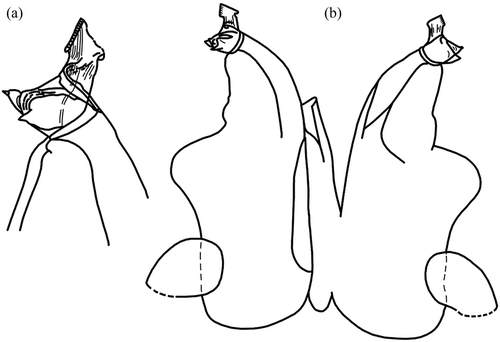
Spelaeoniscus petraliai Caruso & Lombardo, Citation1977a: 53, figs 2–14; Caruso et al., Citation1987: 106; Schmalfuss, Citation2003: 239.
Previous records
Type material re-examined
SICILY: Sambuca di Sicilia (AG)-Serro, 26 March 1976, 10 males and 17 females, type material (MZ-DBA); Noto (SR)-Cava del Carosello, 14 November 1986, four males and 15 females (MZ-DBA); 14 March 1985, one male and four females (MZ-DBA); 1 December 1985, six males and four females (MZ-DBA); Fiume Manghisi, 20 April 1985, two males (MZ-DBA); Sortino (SR)-Contrada Foresta, 22 November 1985, one male (MZ-DBA); Patti (ME)-Laghetti di Marinello, 21 February 1990, two males and 10 females (MZ-DBA); 28 November 1994, one female (MZ-DBA); 22 November 1995, one female (MZ-DBA); Tindari, at the slopes of the Sanctuary, 15 December 1994, 27 males and 10 females (MZ-DBA); Tindari, port, 7 April 1987, one female (MZ-DBA); Palermo (PA)-Parco della Favorita, Vallone del Porco, 13 November 1990, five males and 15 females (MZ-DBA) (Caruso leg.).
Diagnosis
Maximum body length: females 2.5 mm, males 1.7 mm. Specimens without pigment; however, some specimens have traces of pigment near eyes and on the epimera of the pereion and pleon. Male pleopods 1 endopods bent at right angle; apical portion with double tip: upper one laminar and lower one formed by two or three pointed processes. Morphology of first male pleopods as in (Caruso & Lombardo Citation1977a).
Material examined
SICILY: One male holotype, Pineta di Vittoria (RG), 14 February 1987 (MZ-DBA); 29 male and 10 female paratypes, same data (MZ-DBA); 8 March 1990, one female (MZ-DBA); Valle di Acate (RG), 9 January 1982, one male (Caruso leg.) (MZ-DBA).
Description
Maximum body length: females 2.4, males 1.7 mm; maximum diameter 1.4 mm (females) 0.9 mm (males) when rolled up. Colour absent. Eyes are usually absent, occasionally present in trace. Body is covered with imbricated scales, with scale-setae between them, arranged in many rows on tergites; scale-setae bent backwards.
Cephalon with two shallow antennal furrows, extending about 1/3 of length, into which antennae fit perfectly during rolling-up process. Antennal furrows delimit a scutellum that is not very marked though well visible. Antennae short, not surpassing posterior margin of pereionite 1 when extended backwards; flagellum of two segments, first shorter than second, provided with some aesthetascs. Last article of antenna shorter and more thickset in males than in females (a) and (b)). Epimera of pereionite 1 with well visible posterolateral schisma, inner lobe longer and larger than the outer lobe, into which anterior edges of pereionite 2 epimera fit during rolling-up process ((c)). Telson semi-circular with a wide base; uropods trapezoidal with endopodites longer than exopodites ((d)).
Male pleopod 1 exopods small rounded; endopods very stout and bent upwards at right angle; apical portions twisted around their own axis and with rounded tip with one opening; each apex has on its outer edge 4–5 short and rounded well visible evaginations (a) and (b)).
Male pleopod 2 exopods sub-triangular with rounded tip and strong seta on outer edges and with numerous thin setae on inner edges; endopod longer than exopodite, with stout and short base and thin apical part ((c)).
Etymology
The name refers to the territory in which the town of Vittoria is located.
Distribution
Sicilia.
Discussion and conclusions
With the erection of the two new genera, Hybleoniscus and Uncuniscus, the family Spelaeoniscidae is currently represented by nine genera. The other seven are: Atlantoniscus Vandel, Citation1959, Maghreboniscus Vandel, Citation1959, Spelaeoniscus Racovitza, Citation1907, Barbarosphaera Vandel, Citation1948, Desertosphaera Vandel, Citation1948, Triceratosphaera Caruso & Lombardo, Citation1978 and Albertosphaera Caruso & Lombardo, Citation1983. As discussed by Caruso and Lombardo (Citation1978), the morphology of the different genera suggests an evolutionary trend which, starting from species not very able to roll up and with shallow antennal furrows, has given rise, through different steps, to species with a perfected mechanism of rolling up and deep and variously extended antennal furrows. The two new genera are not significantly different from the genus Spelaeoniscus, for these characters, each still represented by more than one species, show a peculiar morphology of the male reproductive apparatus that distinguishes them from Spelaeoniscus.
In conclusion, the genus Spelaeoniscus, as redefined here, includes 10 species (S. debrugei, S. sahariensis, S. kabylicola, S. orientalis, S. coiffaiti, S. lagrecai, S. costai, S. ragonesei, S. vandeli, S. akfadouensis); the new genus Uncuniscus includes three species (U. hamatus, U. singularis sp. nov., U. elegans sp. nov.), reported so far only from Algeria (); and three species, already known from Sicily and Malta (), have been assigned to the new genus Hybleoniscus (H. vallettai, H. petraliai, H. vittoriensis sp. nov.). Spelaeoniscus has a southwestern Mediterranean distribution, i.e. Morocco, Algeria, Northern Sahara, Minorca, Southern Spain, and Sicily and the surrounding islands ( and ). All the other genera of the family are known only from North Africa (Caruso & Lombardo Citation1983): Atlantoniscus from Morocco, Maghreboniscus from Morocco and northern Algeria, Barbarosphoera from northern Algeria and southern Morocco, Desertosphoera from Algeria, Triceratosphoera from northern Algeria, and Albertosphoera from Algeria. This pattern of distribution demonstrates the ancient origin of Spelaeoniscus, which probably originated in the territory of Tyrrhenid during the Tertiary as a result of complex geological events in that region.
Considering the current distribution of the species in the various geographical areas, we can presume that Spelaeoniscus originated in North Africa. The current distribution of the genus Spelaeoniscus seems to be the result of a migration towards the north, i.e. towards less arid regions (Vandel Citation1959).
The North African ancestral species likely underwent an initial adaptive radiation, triggered by the colonisation of different environments, including caves, grasslands, forests, and semi-arid regions, giving rise to new species.
During the Messinian, the closure of the connections between the Atlantic Ocean and the Mediterranean Sea and the subsequent drying of the latter would have made possible territorial connections between North Africa and Sicily, allowing exchanges of fauna and flora (Giachino et al. Citation2011). Later, the probable sub-division of the territory into islands, between North Africa and Sicily, involved numerous attempts at speciation, some of which were successful. Territorial connections (unspecified) between Sicily and North Africa, in particular with the Maghreb, are also suggested by Massa (Citation2011) on the basis of the study of the Sicilian Orthopteroidea; in fact, the author mentions seven species with a Sicilian–Maghrebian distribution.
Thus, the colonisation of Sicily involved a subsequent adaptive radiation resulting as a response to new environmental conditions that induced new adaptations and, hence, the origin of other species. Members of the genus Spelaeoniscus are animals with low vagility, easily tending towards isolation and differentiation; this is demonstrated by the high number of endemic species and by the fact that almost all of the species are very localised, with the exception of S. coiffaiti, known from Spain, the Balearic Islands, Sicily, Pantelleria and Algeria; S. vandeli from Pantelleria, Favignana and Algeria; and S. lagrecai from Sicily, the Balearic Islands and Marettimo.
The presence of S. coiffaiti and S. vandeli in Pantelleria, an island that is entirely volcanic, would suggest that territorial connections existed with North Africa. Such connections, which occurred during the Rissian–Milazzian II, were also suggested by Pasa (Citation1953), Bordoni (Citation1973), Lanza (Citation1973) and Caruso (Citation1976).
The presence of S. costai in Ustica, which is also a volcanic island, at least at present can be explained by passive introduction via plants, foodstuffs, timber or floating rafts, since territorial connections of this island with Sicily or southern Italy seem to have never existed (Caruso Citation1976).
The presence of S. coiffaiti in Minorca and in the Iberian Peninsula can be attributed to human activities.
In general, it is possible that the distribution of Spelaeoniscus, and even more that of the two new genera dealt with in this study, is wider, considering that the animals have low vagility, and are very small, endogean and difficult to collect. Therefore, we deem it probable that representatives of these three genera are present in other coastal locations of the Maghreb, which even today remain poorly explored, as well as in the south of the Italian peninsula.
Acknowledgements
The authors are very grateful to colleagues Pietro Alicata and Maria Teresa Vinciguerra, both expert taxonomists, for deep discussions of the taxonomical problems related to the institution of the two new genera. Moreover, they thank the anonymous referees who improved the quality of this paper with their useful suggestions.
References
- Bordoni A. 1973. I coleotteri Stafilinidi delle isole circumsiciliane. XXI Contributo alla conoscenza degli Staphylinidae. Lavori della Società Italiana di Biogeografia 3:651–754.
- Caruso D. 1973. Isopodi terrestri delle Isole Egadi. Bollettino delle Sedute dell’Accademia Gioenia di Scienze Naturali Catania 4:69–94.
- Caruso D. 1975. Spelaeoniscus vallettai, nuova specie di isopodo terrestre dell’Isola di Gozo. Animalia 2:59–66.
- Caruso D. 1976. Isopodi terrestri dell’isola di Pantelleria. Animalia 3:105–124.
- Caruso D. 1982. Il popolamento cavernicolo della Sicilia. Lavori Società Italiana Biogeografia (N.S.) 7:587–614.
- Caruso D, Baglieri C, Di Maio MC, Lombardo BM. 1987. Isopodi terrestri di Sicilia ed isole circumsiciliane (Crustacea, Isopoda, Oniscoidea). Animalia (Suppl.) 14:5–211.
- Caruso D, Lombardo BM. 1976. Isopodi terrestri dell’isola di Ustica. Animalia 3:225–233.
- Caruso D, Lombardo BM. 1977a. Descrizione di una nuova specie siciliana di Spelaeoniscus (Isopoda, Oniscoidea) e considerazioni sulla distribuzione geografica del genere. Animalia 4:53–60.
- Caruso D, Lombardo BM. 1977b. Ricerche faunistiche ed ecologiche sulle grotte di Sicilia. III. Spelaeoniscus ragonesei nuova specie di isopodo di una grotta dei Monti Iblei (Sicilia) (Crustacea, Isopoda, Oniscoidea). Animalia 4:99–107.
- Caruso D, Lombardo BM. 1978. Spelaeoniscidae nuovi del N-Africa e considerazioni sull’evoluzione della famiglia. Animalia 5:209–226.
- Caruso D, Lombardo BM. 1983. New data on North African Spelaeoniscidae (Isopoda Oniscoidea). Crustaceana 45:15–30. DOI:10.1163/156854083X00154.
- Caruso D, Lombardo BM. 1995. Arthropoda di Lampedusa, Linosa e Pantellaria. Crustacea Isopoda Oniscidea. Naturalista Siciliano (Suppl.) 19:99–114.
- Garcia L. 2006. Presencia de Spelaeoniscus coiffaiti Vandel, 1961 (Isopoda: Crinocheta: Spelaeoniscidae) en la Penìnsula Ibèrica. Boletìn Sociedad Entomològica Aragonesa 38:307–309.
- Garcia L, Cruz A. 1996. Els isòpodes terrestres (Crustacea: Isopoda: Oniscidea) de les illes Balears: catàleg d’especies. Bolletì de la Societat d’Història Natural de les Balears 39:77–99.
- Giachino PM, Vailati D, Baviera C. 2011. I Coleotteri Colevidi della Sicilia: Inventario, analisi faunistica e origine del popolamento (Coleoptera, Cholevidae). Biogeographia 30:467–484. DOI:10.21426/B630110549.
- Lanza B. 1973. Gli Anfibi e i Rettili delle isole circumsiciliane. Lavori Società Italiana di Biogeografia 3:755–804.
- Massa B. 2011. Gli Ortotteri di Sicilia: Check-list commentata. Biogeographia 30:567–626. DOI:10.21426/B630110568.
- Montesanto G, Caruso D, Lombardo BM. 2011. A new species and new records of terrestrial isopods from Sicily (Isopoda: Oniscidea). Journal of Natural History 45:1925–1935. DOI:10.1080/00222933.2011.573099.
- Pasa A. 1953. Appunti geologici per la paleogeografia delle Puglie. Memorie di Biogeografia Adriatica 2:755–804.
- Paulian De Felice L. 1942. Un nouvel isopode saharien. Bulletin du Muséum National d’Histoire Naturelle (2è Ser.) 14:403–405.
- Racovitza E. 1907. Spelaeoniscus debrugei n. g., n. sp., isopode terrestre cavernicole d’Algerie. Archives de zoologie expérimentale et générale (4e Sèr.) 7:69–77.
- Racovitza E. 1908. Biospeologica. IX. Isopodes terrestres (seconde serie). Archives de zoologie expérimentale et générale (4e Sèr.) 9:239–415.
- Schmalfuss H. 2003. World catalog of terrestrial isopods (Isopoda: Oniscidea). Stuttgarter Beiträge zur Naturkunde, Serie A (Biologie) 654:1–341.
- Schmölzer K. 1965. Bestimmungsbücher zur Bodenfauna Europas. Ordnung Isopoda (Landasseln). Lieferung 4 and 5. Berlin: Akademie – Verlag. pp. 468.
- Vandel A. 1948. Les isopodes volvationnels exoantennes et la genese de leurs coaptations. Bulletin biologique de la France et de la Belgique 82:388–428.
- Vandel A. 1955. La faune isopodique cavernicole de l’Afrique du Nord (Berbérie). Notes Biospéologiques 10:63–80.
- Vandel A. 1959. Nouvelles recherches sur les isopodes volvationnels exoantennes et la genese de leur coadaptions. Bulletin biologique de la France et de la Belgique 93:121–139.
- Vandel A. 1961. Les isopodes terrestres de l’Ile de Minorque. Archives de zoologie expérimentale et générale (4e Sèr.) 99:249–265.

